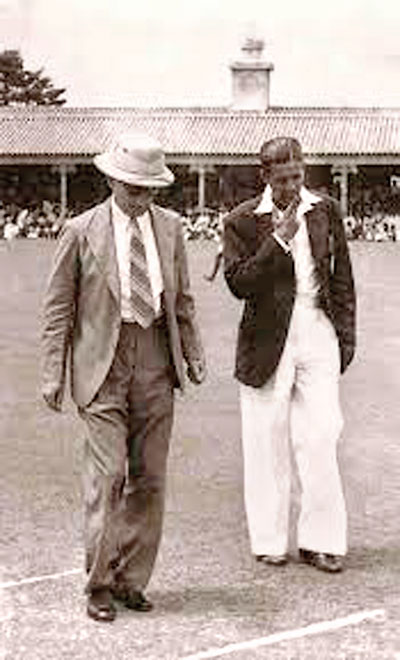Sunday Times 2
The Sathasivam murder case: How police manipulated evidence
Policing the police
Mahadevan Sathasivam was a cricketing great in the mid-1940s. He has been described as a batting genius. Frank Worrel, the West Indian Captain when the West Indies reigned supreme in cricket, had said that the very first batsman he would pick for a World X1 would be “Sathasivam of Ceylon.”

Sathasivam (right) with Don Bradman
Sathasivam was also known for his drinking and weakness for women. In 1940, Sathasivam married Paripoornam Ananda Rajendra, granddaughter of Sir Ponnambalam Ramanathan. Satha had promised to give up his drinking habits and there had been spells when he actually refrained from alcohol.
Sir Ponnambalam Ramanathan has been designated as ‘the greatest Ceylonese of all times’ by no less a person than D.S. Senanayake, the first Prime Minister of independent Ceylon.
In 1949, the Satasivam couple moved to No. 7, St. Alban’s Place in Bambalapitiya with their four daughters. Theirs had been a troubled marriage because Sathasivam had got involved with an attractive outgoing young lady, Yvonne Stevenson of foreign descent. He loved his wife and children and their conservative family life, but his dilemma was that he could not resist the fun and frolic he was used to.
On October 9, 1951, shortly after 3 pm, Mrs. Sathasivam was found strangled on the floor of the kitchen, face upwards with a mortar placed on her neck.
Hewa Marambage William, 18, a resident of Matara, had been employed as a cook by Mrs. Sathasivam only 11 days prior to the murder.
Both Sathasivam and William were arrested on suspicion. Sathasivam the following day, and he had explained his movements that morning which turned out to be consistent with scientific evidence. William was found 10 days later in Tangalle and, when he was taken to Matara Police and questioned, had confessed to the murder by strangulation as well as to selling the jewellery taken from Mrs. Sathasivam’s neck. Injuries on his face had also been noted down and they became important telltale evidence.
In a sudden quake of events, the Inspector General of Police, Sir Richard Aluvihare, KCMG, CBE, JP, CCS, and diplomat, but no training or experience in crime investigation, personally took upon himself the task of conducting the investigation. The investigation as such was to find evidence to connect Sathasivam to the murder, and the police even resorted to manipulating evidence to hang Sathasivam.
Prof. Ravindra Fernando has made a meticulous study of this case to write his book, ‘A MURDER IN CEYLON’. In this book, Superintendent of Police, Colombo (Crimes) Albert de Silva, is quoted as saying while giving evidence, “At no time in this inquiry I wanted to assert the function of this Court to decide the innocence of either of these accused. My sole concern was to find the truth and place them before the Courts. To do this, I was not allowed. The unnecessary interference by the Inspector-General of Police hindered me from doing this.”
Mr. Albert de Silva is described as a recipient of the King’s Police Medal for Distinguished Service, according to the Ceylon Police Gazette of June 30, 1948. He has the highest reputation for honesty and integrity and is known affectionately in the Force as ‘Honest Albert’.
At the end of the non-summary inquiry, on October 16, 1952, Sathasivam and William were committed to the Supreme Court for trial. On the same day the Attorney-General granted a conditional pardon to William and made him a crown witness and was retained in police custody until the termination of the case! With that William did a U turn and implicated Sathasivam in the murder.
The evidence, especially the scientific evidence in this case, is too long to enumerate in this article. Suffice to mention that the trial judge, Justice E.F.N. Gratiaen, severely criticised the conduct of the Ceylon Police in this case. The jury brought in a unanimous verdict of “Not Guilty”.
Apart from prejudice against Sathasivam due to his way of life, public opinion created against him by the Police and the Media was even more formidable and he had to spend 20 months in remand prison for a crime he did not commit, while the real culprit got away scot-free.
An interesting fact that has been shelved is that this same Hewa Marambage William had been employed as a mess-boy in the single-men’s barracks at Udugama Police prior to his employment by Mrs. Satasivam. Single-men’s barracks, especially in an estate area, is the ideal breeding ground for a teen-ager’s sex perversions.
In this context, it is pertinent to quote from page 249 of Prof. Fernando’s book: “Sir Sydney (Smith) said he had considered the possibility of a sexual assault on Mrs. Sathasivam. In fact it had occurred to him and he had asked that investigations be made in that direction even at a later stage.”
Old habits die hard. So it has been with William. Around 1964, when Inspector Ebert Egodapitiya was the officer in charge of the Fort Police, a pimp loitering in the precinct of the Fort Police was arrested on suspicion. On checking his finger prints, he was found to be the same Hewa Marambage William. (National Identity Cards had not yet been introduced to Sri Lanka by that time.)

